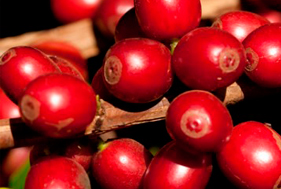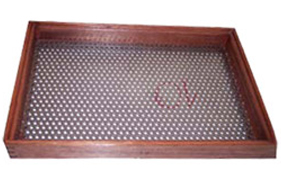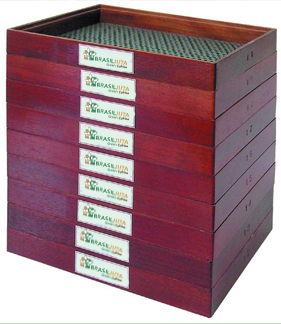
OUR COFFEE

GREEN BEAN CLASSIFICATION
About the Coffee
Coffee like so many other edible vegetable products, has various flavors that depend on its kind, the place of production; influenced by conditions relating to climate, soil, altitude, sunlight and rainfall, in short, by macro and micro geological determinants. Each has its own characteristic flavor, sweetness, acidity, etc.
The coffee is from the Rubiaceae family (commonly known as the coffee, madder, or bedstraw family), with more than 500 genera and 8000 species.
High quality coffee Mogiana region:
Aroma: Striking - Fruity with notes of chocolate and nuts;
Body: Creamy velvet (Main feature of the coffees of the region's High Mogiana);
Acidity: Medium - Very balanced;
Aftertaste: Extended with a sweetness of caramel with hints of bitter chocolate. Excellent foundation for a good espresso.
COFFEE BEAN
The coffee cherry is composed of:
Hull: as it ripens, it turns from green to red or yellow;
Pulp: located immediately after the hull, it is very fleshy;
Mucilage: a viscous layer, rich in sugar, between the pulp and the parchment;
Parchment: inner skin, which surrounds the seed;
Pits or beans: There are two in each cherry (dicotyledon) in the flat kind, or one (monocotyledon) in the mocha kind.
THE GENERAL GRADING OF GREEN BEAN PROCESSED COFFEE is defined by:
1. CATEGORY
2. SUBCATEGORY
3. GROUP
4. SUBGROUP
5. CLASS
6. TYPE
1) CATEGORY
Around the world as in Brazil, mainly two species of coffee are cultivated that make for a better beverage, and therefore are of global significance:
CATEGORY I: Arabica (Coffea arabica);
CATEGORY II: Robusta, also referred to as conilon in Brazil (Coffea canephora).
2) SUBCATEGORY
According to the shape of the bean and its size (determined by the size of the holes in the sieves through which the coffee is able to pass).
On the left/right are the pictures of the sieves that we use to grade the coffee beans.
1. FLAT (CHATO): consisting of beans with an outer convex and an inner flat or slightly concave surface, with a lengthwise central groove.
2. MOCHA (MOCA): consisting of egg-shaped beans, also with a lengthwise central groove. These are derived from what is known as a “peaberry”.
COARSE FLAT (CHATO GRAÚDO): sieves 17/18/19
MEDIUM FLAT (CHATO MÉDIO): sieves 15/16
FINE FLAT (CHATO MIÚDO): sieves 14 and smaller
COARSE MOCHA (MOCA GRAÚDO): sieves 11/12/13
MEDIUM MOCHA (MOCA MÉDIO): sieve 10
FINE MOCHA (MOCA MIÚDO): sieves 9 and smaller
BICA CORRIDA (B/C): Considered when the coffee cannot be separated into sieves, or when it doesn’t fit into four or more screens.
3) GROUP
According to its aroma and flavor. Also graded according to two groups:
1. GROUP I = ARABICA COFFEE: the best has a more pronounced and smoother, more aromatic flavor and a lower amount of caffeine than the Robusta.
2. GROUP II = ROBUSTA COFFEE: the most resistant to pests, it has a neutral flavor and aroma, leaning towards bitter, and a higher amount of caffeine.
4) SUBGROUP I – Group 1 - Arabica (in descending order of quality)
FINE BEVERAGES
STRICTLY SOFT (ESTRITAMENTE MOLE): coffee that combinedly has all the requirements of a “soft” aroma and flavor, though more pronounced.
SOFT (MOLE): coffee that presents a pleasant, mild and sweet aroma and flavor. It is a smooth and balanced coffee.
JUST SOFT: coffee that has a lightly sweet smooth flavor, but an astringent or rugged taste.
HARD (DURO): coffee that has an sourish, astringent and rugged flavor, though it doesn’t have a strange taste. A markedly full-bodied and pleasant beverage.
ACIDIC BEVERAGES (BEBIDAS FENICADA)
RIADO: coffee that has a light flavor, characteristic of iodoform.
RIO: coffee that has the characteristic and pronounced iodoform flavor. A coffee has an intense and striking flavor.
RIO ZONA: coffee that has a very pronounced aroma and flavor, similar to iodoform or carbolic acid, with a repugnant taste.
4) SUBGROUP II – Group II - Robusta
EXCELLENT: coffee that has a neutral flavor and average acidity.
GOOD: coffee that has a neutral flavor and slight acidity.
REGULAR: coffee that has the characteristic Robusta flavor with no acidity.
ABNORMAL: coffee has a non-characteristic flavor to the product.
5) CLASS
Grading of Processed Green Bean Coffee according to its color
BLUISH GREEN (VERDE AZULADO) AND CANE GREEN (VERDE CANA): characteristic of coffee that has had its pulp and mucilage removed.
GREEN (VERDE): bean of green color and its nuances.
YELLOWISH (AMARELADA): bean of yellowish color, indicating signs of the aging of the product. YELLOW (AMARELA)
BROWN (MARROM)
LEADISH (CHUMBADO)
WHITISH (ESBRANQUIÇADA)
ASSORTED (DISCREPANTE): mix of colors derived from different crop or color varieties.
6) TYPE
Grading of Processed Green Bean Coffee according to the presence of defects and foreign objects.
Processed green bean coffee is the endosperm of the fruit of various species of the genus Coffea, mainly Coffea arabica and Coffea conephora (robusta or conilon.)
FOREIGN OBJECTS AND IMPURITIES
Objects foreign to the coffee: plant debris not derived from the product, grain and seeds of other species and foreign bodies of any nature, such as stones and lumps, which are derived from sweeping or from fragments of the drying terrace floor.
The maximum percentage of foreign objects and impurities permitted in the Processed Green Bean Coffee is 1%. The product in excess of this amount will be temporarily downgraded.
Impurity: dry or green hulls of various fruits, including coffee, sticks, branches and other impurities of the product itself.









